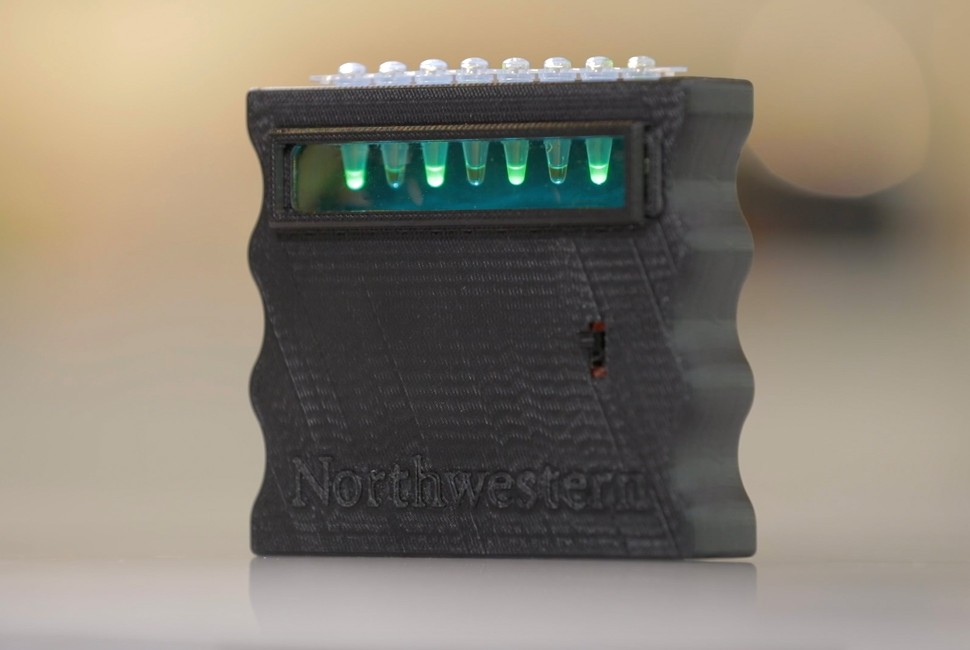An unplugged electric instrument may function, but it sounds much better when it is connected to an amplifier. Similarly, toxins and other small molecules at low concentrations in the environment or human body may emit quiet signals that are undetectable without “amplification” via specialized lab technology.
Thanks to a “cool trick in biochemistry” used to adapt a sensing platform already being deployed by Northwestern scientists to measure toxins in drinking water, researchers can now detect and even measure chemicals at low enough concentrations to have use outside the lab. By attaching circuitry akin to a volume knob to “turn up” weak signals, the team opened the door for the system to be applied to disease detection and monitoring in the human body for nucleic acids like DNA and RNA, as well as bacteria such as E. coli.
The results, published in Nature Chemical Biology, describe a system that is 10 times more sensitive than previous cell-free sensors built by the team.
“Biosensors repurposed from nature can, in principle, detect a whole spectrum of contaminants and human health markers, though they’re often not sensitive enough as is,” said corresponding author and Northwestern synthetic biologist Julius Lucks. “By adding genetic circuitry that acts like an amplifier, we can make this biosensing platform meet sensitivity levels needed for application in environmental and human health monitoring.”
Lucks is a professor of chemical and biological engineering at Northwestern’s McCormick School of Engineering and a co-director of the Center for Synthetic Biology.
Meet ROSALIND 3.0 (and its ancestors)
The original model of the sensing platform, called ROSALIND (short for “RNA output sensors activated by ligand induction”), could sense 17 different contaminants in a single drop of water, glowing green when a contaminant exceeded the U.S. Environmental Protection Agency’s standards. Lucks and his team created it using an approach called cell-free synthetic biology, in which molecular machinery – like DNA, RNA and proteins – is removed from cells and reprogrammed to perform new tasks.
A second model of ROSALIND enabled the platform to compute different concentrations of contaminants. Lucks uses the history of the transistor radio to explain advances in the sensing platform, now in its third iteration.
“You could build the first transistor radio in your Electronics 101 class, and it gets a radio signal, but it has all sorts of problems,” Lucks said. “If you walk behind a tree, you will lose signal, and if you walk closer to the source, it will get louder. In future generations of that radio, they added additional electronic circuitry to control for and correct those things. This iteration is basically adding a volume knob to the radio.”
A useful bug in the system
Synthetic biologists working with DNA and RNA often run into an unhelpful nemesis called T7 RNA polymerase enzyme. The enzyme can act like a bug in the system, munching up snippets of RNA that it is not supposed to and wreaking havoc on nucleic acid circuits. But the researchers have used it to their advantage, with Lucks comparing it to the radio battery for its role in pumping out output signals.
With a signal amplification trick from DNA nanotechnology that allows a circuit to recycle and replay its input, the researchers found a method to boost an input molecule’s signal. When a signal is generated, the “bug” eats and recycles it, generating another signal. The result allowed the team to detect molecules — like antibiotics and heavy metals — at a fraction of the concentration as previous iterations.
“We created a new system to amplify signals in ROSALIND,” said first author Jenni Li, a Ph.D. candidate in the Lucks lab. “Due to a cool trick in biochemistry, this lets us sensitize the system to detect compounds at lower levels without changing the actual biosensor protein. This is all done in nucleic acid ‘circuits.’ ROSALIND 3.0 is now more sensitive and can detect nucleic acids when it could previously only detect small molecule compounds.”
ROSALIND at work
Researchers have already deployed previous iterations of ROSALIND in real-world settings, for example, in an ongoing field study in the Chicago area detecting lead in drinking water. According to Lucks, new elements of the team’s “3.0” model can be easily applied to this and other projects.
“We are also developing ROSALIND to detect human health markers, food quality markers and agricultural compounds, opening up what this platform technology can be used for,” Lucks said. “This new sensitization approach is general, meaning that we will more quickly be able to develop sensors that can detect compounds at actionable levels in the future.”
Northwestern startup company Stemloop is commercializing the ROSALIND technology. Lucks has financial interests in and affiliations with Stemloop. Northwestern has financial interests (equity, royalties) in Stemloop.


